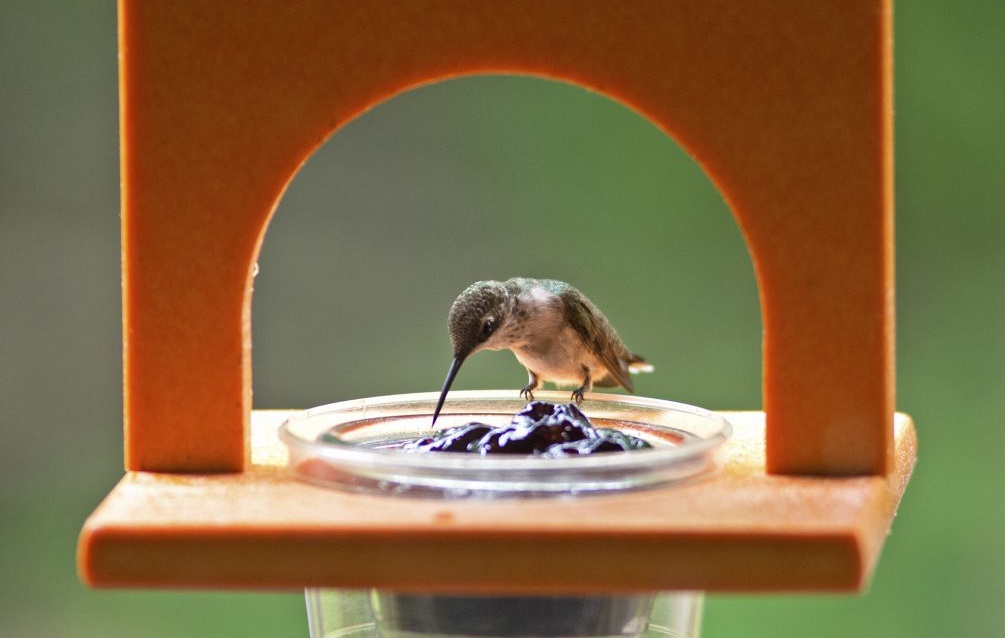

We’re here to help! Wild Yards is a completely free website that is 100% dedicated to helping you create a wildlife-friendly, sustainable yard. Read more
WildYards is reader-supported. When you buy a product through a link on our site, we may earn a comission. Every product is independently selected by our (obsessive) editors and our reviews are unbiased and objective. Read more about our mission or our privacy policy.
Hummingbirds are famous for their sweet tastes – many refer to them as the ‘sugar addict’ of the garden. They’ll commonly seek out sugary nectar from various plants to help boost their calorie intake. But do hummingbirds eat grape jelly and other treats?
Hummingbirds love grape jelly. As you’d expect, they are naturally attracted to sugar – but be careful, as you’ll need to ensure any treats you leave out for the birds contain natural sugars alone.
Why do hummingbirds eat jelly?
The hummingbird has an incredible metabolism that demands a human equivalent of more than 150,000 calories a day – and much of that will come from sugar. Hummingbirds eat sugary treats regardless of whether they are natural (such as flower nectar) or if you provide it to them in a feeder.
Hummingbirds find fruit refreshing, and while they won’t always seek it as a priority over flower nectar, they’re known for drinking from oranges, eating watermelon, and enjoying the occasional piece of apple. Understandably, sugary, natural grape jelly will easily attract a hummingbird.
Sugar famously provides an instant ‘boost’ of energy that, in many cases, is short-lived. The hummingbird has evolved and adapted to top up on sugar constantly, despite its lack of other useful vitamins and nutrients. Therefore, natural fruit jelly is likely to provide a diversion from other sugars in your garden, but it’s normally a good idea to let your local hummers seek out nectar as a priority because it’ll help them pollinate, for example.
Hummingbirds need quick-fix sugar as a result of their breath-taking physical activities. On average, the hummingbird will flap or beat its wings up to 80 times per second, a record no other bird can beat. It’s also the only bird that can fly backward – and it almost constantly hovers in the air, even while feeding.
Should I feed hummingbirds grape jelly?
There’s no harm in providing a cube of grape jelly to your hummingbirds in their feeders occasionally, but always check the packet before you dish out. It’s never a good idea to feed any wild animals artificial sugars and flavorings. Hummingbirds have evolved to only process the sugar they find in the wild – sucrose and glucose, for example – and consuming artificial sweeteners may make them ill.
Many wild yard owners would likely recommend growing natural sugar first before providing sweet treats out of the kitchen for hummingbirds. Setting up a feeder is a great option if there’s a lot of competition for nectar in the garden. Beyond that, focus on growing your beds and flowers to the standard hummingbirds demand before relying on grape jelly outright.
What else do hummingbirds eat?
Given their love of sugar, it’s easy to assume hummingbirds love nectar from plants, flowers, and trees above all else. Their diets are a little more complex – they do, of course, demand protein and balanced nutrients from elsewhere in your garden to survive.
Beyond dipping into pieces of grape jelly at the feeder, hummingbirds will normally feed on insects, bugs, and winged minibeasts that come their way. They may come across ants, for example, who compete for sugary food and nectar. Given ants’ high reproduction rates, hummers will frequently pick them off if they get in the way of flowers or fruit.
Handily, hummingbirds will also pause during jelly and nectar feasts to eat mosquitoes. They’ll also take care of aphids and may even eat spiders. In many ways, hummingbirds provide a natural pest control service, providing you attract them with the best plants, flowers, and food sources.
Given the choice between grape jelly and natural flowers offering abundant nectar, the latter is a safe bet for most hummingbirds. There are many hummingbird-friendly flowers easy to grow in US gardens, such as jasmine, zinnias, impatiens, azaleas, and snapdragons.
Focus on growing bright, fiery-colored flowers with tubular or trumpet-shaped blooms. These specimens are most attractive to hummingbirds, and their shape will allow them to dip their beaks deeply into the nectar.
It’s a great idea to try and supplement your hummingbirds’ diets with treats such as grape jelly. They need all the calories they can get – but remember, natural food is a priority to keep these pollinators healthy, happy, and returning to your yard.
